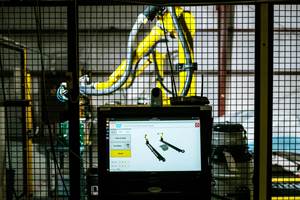Q. How fast will ceramic media wear in a vibratory finishing machine? I’ve determined that our media (a cone-shaped ceramic media made in China) is 20% consumed in 6 hr of finishing. H.G.
A. First of all, a wear rate over 3% an hour is totally unacceptable. This customer did not state if his media that wears over 3% per hour is also a very fast-cutting composition. He stated that they flow 3–4 gal/hr of compound per cubic foot to keep the parts clean. This media cannot cut fast enough to justify its very high wear rate and the very high compound use rate. There are also related problems that are very costly, such as the volume of sludge created. Every pound of media purchased becomes a pound of ceramic dust that settles in drains, tanks, centrifuge bowls, and worst of all, on parts themselves.
There are at least 10 basic compositions of ceramic media manufactured in the U.S. Each will have its own characteristic wear and cut rate resulting from the size and shape of the media, size and mass density of the parts, depth of the bowl, the amplitude and frequency of vibration, compound flow rate, compound lubricity, machine drainage, and whether parts are loose or fixtured in the process chamber.
In general, the faster the media cuts, the faster it will wear. Media also wears more slowly in round machines and in flow-through tub machines than in closed-batch tub styles. Wear rate is expressed as percent of media weight lost in one hour of processing. The weight loss for good quality cutting media will range from about 0.25–0.75%/hr. Fast-cutting media such as silicon carbide can wear as high 1%/hr, and polishing media with little or no cut may wear at less than 0.15%/hr.
Some manufacturers have prepared charts to compare metal removal rate with media wear rate for different compositions. An efficiency index is calculated by dividing the metal removed by the percent of media consumed. This index must be used only along with other factors for making a media selection.
The relationship of media geometry to wear rate is very important and little understood. Most articles on the subject only deal with the media lodging and the ability to reach all areas of the part that need to be deburred or finished. Since we are dealing here with media wear rate, it is opportune to discuss media geometry in that light.
A media manufacturer published test data showing that a particular composition would wear at 0.5%/hr. This composition is in the category of “good cutting and good finish.” Every media manufacturer has at least one product in that category, and it is generally their most popular composition. I maintained records over several years using 1-inch media of that composition in several 20 ft3 bowl machines, cutting and finishing forged steel parts at 7 mm amplitude. The parts-to-media ratio was very high, which will result in faster wear on the media. In spite of this and aggressive machine settings, the wear rate was only 4 lb/hr, or about 0.25%/hr.
Why was the wear rate only half of the manufacturer’s own published claim? First, look at the wear test parameters: The media was 3/8-inch angle-cut triangles; the machine was a 2 ft3 tub style; amplitude was 3.5 mm; frequency was 1750 vpm; the test pieces, six in the load, were 1 × 3-inch angle-cut steel. This information would lead you to project a much higher wear rate in the larger machines with twice the amplitude and a higher part/media ratio.
Machine settings in a bowl dramatically affect media wear rate, and so does media glazing. These machines were all adjusted to operate identically to give good cutting and a smooth roll. The media was not glazed. The big difference, and this has been demonstrated in dozens of other applications, is the media geometry. The geometry used here was the WEJ, also known as tri-cyl, double-cut cylinder, and some other names. In those days (more than 30 years ago) only one media manufacturer made the WEJ. Today, all the domestic producers offer it.











.jpg;maxWidth=300;quality=90)











